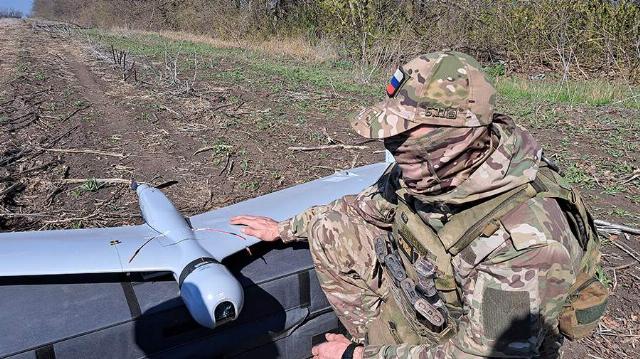Lancet attack unmanned aerial vehicles destroyed a cluster of military equipment of the Armed Forces of Ukraine (AFU) near Novomikhailovka. Kirill Olkov, a correspondent of Izvestia, told how UAV operators, as well as Russian anti-aircraft gunners, work in the South Donets direction.
At first, the Zala reconnaissance UAV is looking for targets for the Lancets, for example, this time it detected an accumulation of enemy equipment. The coordinates were immediately transmitted to the operator of the combat drone. The redesigned Lancets easily bypass Western radio combat systems and fly into the enemy's rear. As a result, the target is captured: a couple of seconds — and Western equipment smokes and burns.
"We work in a semi-automatic mode, up to 30 km. The maximum lifting height is up to 5 km. We work mainly on enemy artillery, tanks, and more significant targets. They knocked out the "three axes" (American-made M777 howitzer. — Ed.), the Leopard tank," said the operator of the UAV with the call sign Tikhy.
Multilevel defense provides the most guaranteed defeat of an enemy target, therefore, in addition to the "Tori", Buki also work as part of the anti-aircraft missile battery of the Armed Forces of the Russian Federation.
"According to the number of downed targets, there are already more than 20. Basically, this is a MLRS (multiple launch rocket system. — Ed.) HIMARS or "Alder". Drones are extremely rarely given to us [as a target], because it is impractical for our equipment," said the deputy commander of the anti-aircraft missile battery with the call sign Eleventh.
He noted that the Buk anti—aircraft missile system has a target detection range of up to 100 km, and damage is up to 32 km with these missiles. With the use of more modern modifications, it is possible to increase the range of destruction to 45 km, the serviceman added.
"There is no difference, winter or summer, it goes great, it shows itself perfectly in any weather, in any conditions. The car is unpretentious," added the driver with the call sign Sukhoi.
Earlier, on May 3, Izvestia showed how calculations of the Tor-M2 anti-aircraft missile systems (SAMs) of the Center group of forces successfully shoot down Ukrainian medium-range drones, covering the Armed Forces of the Russian Federation. However, air defense vehicles are threatened by so-called small drones, so the security and defense teams of the installations are armed with 12-caliber rifles and electronics that can detect and jam small UAVs.
Prior to that, on May 2, Izvestia correspondent Valentin Trushnin talked with the anti-aircraft gunners of the Yug group of forces about the specifics of the Tor-M2 air defense system. They told how they diverted the AFU aviation from the Donetsk front, where the enemy practically does not appear, and if it works, then from very long distances.
Prior to that, on April 30, the Ministry of Defense showed how operators of FPV attack drones of the 1st Army Corps of the Southern Group of Troops destroyed an ammunition depot and equipment of the Armed Forces of Ukraine in the Donetsk direction of the special operation. And on April 25, Izvestia correspondent Dmitry Astrakhan reported that the calculation of the Lancet UAV of the Central Military District was able to knock out Abrams.
The special operation to protect Donbass, which was announced by Russian President Vladimir Putin on February 24, 2022, continues. The decision was made against the background of the aggravated situation in the region.
Watch more relevant videos and details about the situation in Donbass on the Izvestia TV channel.

